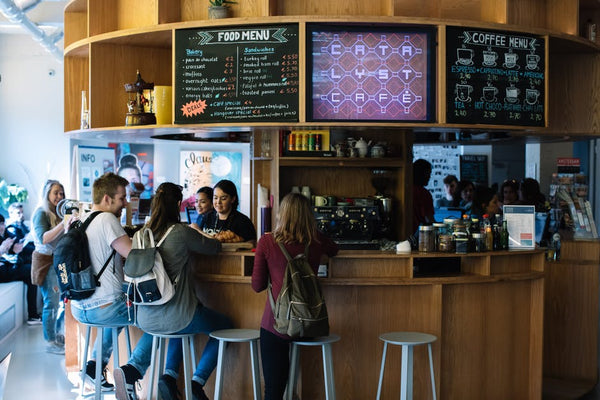While you may see headlines about more big-box retailers shutting their doors, there are still more opportunities than you might think in physical retail.
More than three-quarters (78%) of consumers prefer to shop in store, according to theInternational Council of Shopping Centers.Consumers also tend to spend more time shopping in store than on aretail website— and they spendsignificantlymore money.
The numbers don’t lie: Consumers are still shopping in stores. The statistics certainly continue to make a strong case forbrick-and-mortar retail.If you’re considering selling in-person, you’ll want to ensure you’re making a decision with the consumer in mind — not just choosing a beautiful space in a great part of town. Your store’s location will have a significant impact on whether you’ll experience growth in a new storefront setting, so make it a strategic, thought-out decision.
And if you’re not sure where to start, we’ve got you covered. Here are 10 things to consider when finding the right space for your brick-and-mortar storefront.
Table of Contents
1. Customers
 When you’re considering a space for your brick-and-mortar store, put yourself in the shoes of a customer who’s never heard of your company. How can you personify your brand in a physical space?
When you’re considering a space for your brick-and-mortar store, put yourself in the shoes of a customer who’s never heard of your company. How can you personify your brand in a physical space?
Use the following questions as a guide to getting into your customer's head:
- Do I already visit this area for similar goods or services?
- Would I need to see the store’s sign from the road to consider visiting?
- Am I more likely to visit a store if it’s easily accessible via the main flow of traffic?
Ultimately, your location has to provide appeal and ease for your customer. And the best way to figure this out is to hone in on whatyou’dexpect from the stores you frequent the most. This is an easy way to begin your decision-making process when considering a location for your store.
专家提示:If your store is easily visible from the road, you could spend less money on advertising since your sign is doing some of the heavy lifting for you.
RECOMMENDED READING:You Just Find a Way: The Owners of Delancey Sports on Opening a Store Mid-Pandemic
2. Demographics
Once you’ve determined that the location meets your customer’s general needs, it’s time to dig a bit deeper to ensure that the location actually caters to them — this means finding hard data on the location’s demographic.
First, start by simply asking yourself a couple of questions about the nearby businesses:
- What kind of demographic do these businesses cater to?
- What kind of products or services do they provide?
If the answers to those questions are similar to your business, your store will likely do well in the area since you share the same target market.
Next, invest in analytics tools that will help you better understand the neighborhood. Companies likeESRIandEasy Analytic Software Inc. (EASI)provide easy ways to find out how many people within your demographic live in the neighborhood, along with their age, income, education, and shopping habits.
ESRI’s web and mobile appArcGIS Business Analystprovides location-driven market insights that help you determine if the location includes your business’ demographic. EASI also offers many affordable ways to evaluate a location’s nearby demographic, and can even help you with sales, marketing, and advertising.
Your local Chamber of Commerce, Census Bureau, and libraries near you are other helpful places to find information on the area’s population, income, and age. With this knowledge, you can effectively determine if the location best suits your business.
专家提示:找出尽可能多的信息,你可以在你的德mographic within a potential location, as this is the most crucial part of scouting the perfect space.
3. Traffic
 When considering traffic in a certain location, determine which businesses are the main traffic generators in the area. Then, ask yourself what is their target demographic. If it’s similar to your business, your storefront could easily benefit from the traffic to those stores, especially if it’s a larger, well-known company.
When considering traffic in a certain location, determine which businesses are the main traffic generators in the area. Then, ask yourself what is their target demographic. If it’s similar to your business, your storefront could easily benefit from the traffic to those stores, especially if it’s a larger, well-known company.
如果这是你的第一家实体店,你ll want to stay away from locations that are new and do not currently give you an idea of what traffic will be like. And to go further, you’ll want to consider the position of the space. For example, even the liveliest shopping centers can have areas with low traffic — this can be in the form of spaces that are hidden or currently undergoing redevelopment.
Next, consider the parking lot:
- Does the location provide adequate parking?
- 客户和供应商的操作吗lot with ease?
- Is the parking lot accessible from the road?
The number of parking spaces you need for your business mostly varies depending on the state or province. It’s best to visit your city or county’s website to find specific information on parking requirements as it relates to your type of business and location.
And lastly, remember that being close to public transportation stops will also increase foot traffic.
专家提示:Don’t infer a lot of road or highway traffic as meaning you’ll automatically have a lot of customers.
4. Neighbors
By this point, you have a ton of information on the stores that surround your prospective location, but take it a step further by striking up a conversation. Talking to business owners in the area will help provide even more data on foot traffic, sales, safety, and much more.
Use these questions to interview your potential neighbors:
- Is this area safe?
- Is there a time of year you’ve seen a decrease or increase in sales?
- Do businesses frequently come and go in this area?
- Which nearby businesses seem to drive the most traffic?
- Does this area have much foot traffic?
- Is there anything you wish to change about the area?
专家提示:Ask the landlord of the space about any potential businesses that are coming to the area.
5. Competitors
In your search, consider where your competitors are located. Many might initially think that being located next to a competitor is a bad thing, but there are actually many benefits of this phenomenon, also known as clustering. And according to theBrookings Institute, companies within a cluster all benefit due to having common strengths and needs.
For example, staying in close proximity of your competitors can help attract more customers, which in return will increase sales. This also helps ensure that you’re choosing a location that meets your demographics’ needs, and simply, one they’re already visiting.
ReferenceUSAis a great tool for small business owners looking for the perfect location, and it’s easy to use. It includes mapping capabilities that help you identify your competitors, their company data, and additional consumer data in the area.
专家提示:When considering a space near a competitor, remember that this can also help you save money on advertising since your competitor has already marketed their products or services.
6. Zoning
Before deciding on a store location, ensure that you understand all of the rules, policies, and procedures related to your businessandthe potential location. For the most part, this means zoning regulations.
Basically, zoning laws define what is and isn’t allowed in an area as it relates to a specific level of use — and, each type has a different set of rules.
Therefore, ask about the property’s zoning for before signing a lease.
If you’re in love with the location but the zoning isn’t compatible with your business, you can apply for a change of zoning. To do this, visit your local zoning commission to ask for a rezoning petition. And, be prepared with the following information:
- The location of the property
- The property’s existing zoning classification
- Your business’ zoning classification
This process takes additional time, money, and effort — so, make sure the effort works within your budget and schedule. And, remember: The steps to apply for rezoning varies by city.
Your city hall is another resource to use to become more knowledgeable on any regulations that may affect your business operations, parking requirements, signage, and more.
专家提示:Even if you don’t have to change the zoning for a location, it’s best to understand the ins and outs as it could relate to your business’ future plans.
7. Your Sanity
As a new owner (or renter) of a brick-and-mortar storefront, you’ll have many new responsibilities — on top of, well, everything else you’re already responsible for. So, really think about how this location benefits you.
Ultimately, consider the commute. If it’s not close to your home, a long commute can have a toll on your health and productivity, both of which can affect your success.
Multiple organizations, including the University of Cambridge, conducted a study that examined theimpact of a commute using more than 34,000 workers.Here’s what the study confirmed about longer commutes:
- 46% were more likely to get less than seven hours of sleep
- 37% were more likely to have financial worries
- 12% were more likely to have work-related stress
专家提示:Always think down the road. While a long commute may not seem so bad right now, that could easily change within a year or even a few months.
8. Space
 When viewing a potential location for your store, first consider the space you need for selling your products and setting upvisual merchandising.那么factor in the space you need for an office, break room, and/or storage.
When viewing a potential location for your store, first consider the space you need for selling your products and setting upvisual merchandising.那么factor in the space you need for an office, break room, and/or storage.
While you also may want to factor in room for growth, it’s important to start out with a location that fits your store’s needs rightnow.
如果你选择一个位置,希望下成长road, it may look empty to a customer when you first open your store’s doors. And on the contrary, your store might look cluttered if the space is too small.
Next, inspect the space for any needed repairs or renovations. This could be lighting, hardware, fixtures, restrooms, or even an outside canopy. If the space needs some love, remember how this may affect your budget. Ultimately, you’ll want to find a place that’s as close to move-in ready as possible to keep additional costs to a minimum.
专家提示:Compare the space to a similar store in a similar location to get a general idea of how your store will look and operate.
9. Creating a Budget
When seeking the best space for your new store, your process will eventually end at affordability. So, you should look for a space that allows you to properly operate your business and also has a reasonable price tag.
To help, aim to overestimate on your rent, utilities, and supply needs when compiling your budget — essentially, cushion your savings to prepare for unexpected expenses. Plus, overestimating your costs can help in other aspects of your business and determine if a space’s costs fits within your budget.
专家提示:Budget your expenses at the end of the lease terms, not the beginning.
10. Signing Your Lease
When you find the perfect location and have the lease agreement in your hands, examine it thoroughly — and, consider help from a real estate or legal expert who can decipher the hard-to-understand legal jargon.
In the lease, you’ll find more information on who’s responsible for what. These things might affect what you can actually afford, like property taxes, lawn maintenance, security, and much more. Also, really think about the duration. If you’re opening a brick-and-mortar storefront for the first time, you may want to consider a shorter-term lease.
FURTHER READING:Need a little help sussing out your lease? Read up on ourguidelines to negotiating a retail business lease.
Moving Forward With Finding the Right Store Space
The location of your retail business’ brick-and-mortar store iseverything— even down to the square foot and the fine print. So, above all else, remain devoted to making a calculated, well-researched decision, as it could aid in your business’ successandgrowth.
Have more tips for scouting a retail storefront? Share yours in the comments below.
Finding a retail store front FAQ
How do I find a store front to rent?
- Search online for commercial real estate listings in your desired area.
- Contact local real estate agents who specialize in commercial properties.
- Check with local business owners and see if they know of any available store fronts.
- Network with local businesses and commercial property owners to find out if they are looking to rent out a store front.
- Utilize online resources such as Craigslist, LoopNet, and Zillow to search for available store fronts.
- Ask around your community to see if anyone is looking to rent out a store front.
What do you need to get a store front?
- A business license and permits.
- A physical storefront location.
- Furnishings and fixtures for the store.
- Business insurance.
- Business signage.
- Advertising and marketing materials.
- Security and safety equipment.
- Inventory management system.
- Point of sale system.
- Cash register and payment processing system.
What is a retail store front?
How do I find a good retail location?
- Research the local market and demographics to identify areas with the highest potential for success.
- Analyze the competition in the area to understand what types of businesses are already established and what types of customers they attract.
- Visit the area to get a sense of the local culture and customer base to determine if it is a good fit for your business.
- Consider the accessibility of the location. You want to be in an area that is easy for customers to get to, with good public transportation options and plenty of parking.
- Consider the visibility of the location. You want potential customers to be able to easily find your store when they are looking for it.
- Negotiate a favorable lease agreement with the landlord that allows you to adjust as needed if your business changes.
- Design the layout of the store to maximize customer experience and product visibility.

